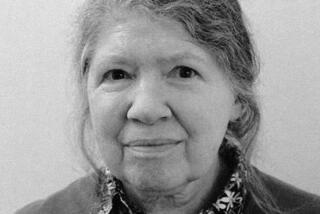Review: The reality behind Laura Ingalls Wilder’s ‘Little House’ books
In summer 1930, Rose Wilder Lane, daughter of the then-unknown Laura Ingalls Wilder, wrote in her diary: “Working on my mothers [sic] story — stupidly, for will it come to anything?”
Wilder had just drafted a memoir about growing up in a pioneer family in the 1870s. Lane, then an established author and journalist with many works of fiction and nonfiction to her name, had been encouraging her. The crash of 1929 had wiped out the family’s investments and Lane was eager to send something new to her agent.
Though his response to her mother’s memoir was lukewarm, Lane persisted, and two years later, after rejections, revisions, a new agent, a new editor and a transformation of the memoir into fiction, Harper & Brothers published “Little House in the Big Woods” by Wilder.
It would be the first in a series of seven children’s books based on “Pioneer Girl.” Wilder and the “Little House” books would go on to enduring, international fame; Lane would fade into obscurity.
The story of how this beloved series came to be has drawn great interest in recent years, as critics have debated Lane’s role: How much of the “Little House” books did she revise or even write herself? Lane always insisted that she merely edited them; she didn’t believe there was much prestige in “juveniles.” At the same time, her diaries and letters reveal an intense and entwined relationship, and writing mentorship, between daughter and mother.
“Pioneer Girl: The Annotated Autobiography,” painstakingly annotated by Pamela Smith Hill, author of the biography “Laura Ingalls Wilder: A Writer’s Life,” publishes Wilder’s original memoir for the first time, presenting a crucial addition to the world of Wilder lore and scholarship while continuing to raise questions about authorship.
The text of “Pioneer Girl” reads like an outline of the entire “Little House” series (minus “Farmer Boy”) in a sped-up first-draft dash. It’s episodic and linear, with chapter breaks inserted by Hill. Because it was intended for an adult audience, Wilder doesn’t avoid the bleaker side of homesteading: financial woes, affairs, divorces, drunks, domestic violence.
The most intriguing part of the manuscript concerns the years the Ingalls family spent in Iowa, omitted from the “Little House” books because the events were too grim, beginning with the death of Laura’s baby brother.
The family has to work in a hotel near a saloon in Burr Oak, a “dead town…without even a railroad.” One night, when Laura is 13 and staying with another family to take care of their baby and ill wife, she is awakened by the husband: “I could smell the whiskey on his breath…[‘]lie down and be still!’ ‘Go away quick,’ I said, ‘or I will scream for Nannie.’ He went and the next day Ma said I could come home.”
Hill’s meticulous notes, which account for about half of “Pioneer Girl,” provide rich historical context for every setting, incident and character, even minor ones. Some of the revelations are startling: a wealthy neighbor asks to adopt 10-year old Laura, a sign of the Ingalls family’s severe financial struggles; at one point, Pa threatens to skip town without paying rent; the real-life Rev. Alden, saintly in the books, turns out to be “a pious fraud and a cheat.”
Hill’s research, involving census data, letters, archives and land records, is nothing short of astounding. Photographs, illustrations, charts and maps add to the museum-like experience.
It’s impossible not to compare Wilder’s memoir to the “Little House” books and wonder how her anecdotes, absent of narrative arc, evolved into the carefully plotted series that so many have grown up reading. It’s also difficult not to consider Lane’s own work, especially her novels “Let the Hurricane Roar” and “Free Land,” which show a strong similarity in subject matter and storytelling to “Little House.”
Hill does not focus much on the letters exchanged between Wilder and Lane during the writing and revising of the books, perhaps because of the scope of their correspondence. She also edges past most of the issues of racism, sexism and Manifest Destiny that many scholars have discussed. As a result, her stance on the question of authorship — that the books are entirely Wilder’s and that Wilder simply grew as a writer — seems more nostalgic and hopeful than convincing. The “Little House” books do include many of the same descriptions seen in “Pioneer Girl,” but a tremendous amount of plot, characterization, conflict, dialogue and scene development had to be added. Wilder’s abilities would have had to improve dramatically in just a couple of years. While her prose can be charming, it’s often utilitarian or clunky, as in this explanation of her courtship with future husband Almanzo: “After all we had been through blizzards, near-murder and danger of death together and those things do create a ‘tie that binds,’ more or less.”
No doubt, critics and fans will continue to debate the role that Lane played in shaping the “Little House” books. “Pioneer Girl: The Annotated Autobiography” is sure to enliven the discussion. It is a long-awaited treasure that provides invaluable, contextualized access to the origins of an American classic.
Nguyen is the author of three books, including “Pioneer Girl,” a novel about a scholar who uncovers a connection between her Vietnamese American family and the legacy of Laura Ingalls Wilder.
Pioneer Girl: The Annotated Autobiography
Laura Ingalls Wilder, edited by Pamela Smith Hill
South Dakota Historical Society Press: 472 pp., $39.95
More to Read
Sign up for our Book Club newsletter
Get the latest news, events and more from the Los Angeles Times Book Club, and help us get L.A. reading and talking.
You may occasionally receive promotional content from the Los Angeles Times.







